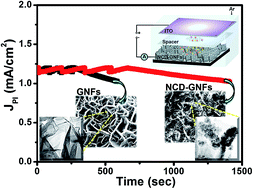Growth, structural and plasma illumination properties of nanocrystalline diamond-decorated graphene nanoflakes
Abstract
The improvement of the plasma illumination (PI) properties of a microplasma device due to the application of nanocrystalline diamond-decorated graphene nanoflakes (NCD-GNFs) as a cathode is investigated. The improved plasma illumination (PI) behavior is closely related to the enhanced field electron emission (FEE) properties of the NCD-GNFs. The NCD-GNFs possess better FEE characteristics with a low turn-on field of 9.36 V μm−1 to induce the field emission, a high FEE current density of 2.57 mA cm−2 and a large field enhancement factor of 2380. The plasma can be triggered at a low voltage of 380 V, attaining a large plasma current density of 3.8 mA cm−2 at an applied voltage of 570 V. In addition, the NCD-GNF cathode shows enhanced lifetime stability of more than 21 min at an applied voltage of 430 V without showing any sign of degradation, whereas the bare GNFs can last only 4 min. The superior FEE and PI properties of the NCD-GNFs are ascribed to the unique combination of diamond and graphene. Transmission electron microscopic studies reveal that the NCD-GNFs contain nano-sized diamond films evenly decorated on the GNFs. Nanographitic phases in the grain boundaries of the diamond grains form electron transport networks that lead to improvement in the FEE characteristics of the NCD-GNFs.


 Please wait while we load your content...
Please wait while we load your content...